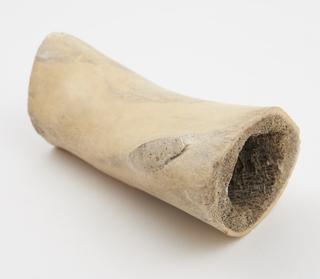

Seal of turned and engraved bone
Earthenware cinerary urn containing quantity of bones
100 BCE-300 CE
Fragments of a right femur
before 1 BCE
Distal section of a right femur
before 1 BCE
Ethnographic object
1880-1915
Bone after being calcined
Small sections of a skull of a prehistoric North American individual
1000-1700
Human left femur
100 BCE -200 CE
Amulet in the form of a human figure made from knuckle bone
1800-1900
Bone fragments from inside a Roman glass cinerary urn
101-230 CE
Bone flute
1851-1920
4 human bones carved to sharp point one end
1871-1900
Human Tibia Bone
1855-1900
Left Humerus (arm bone) from an adult female
1855-1900
Femur bone from a prehistoric cemetery
before 1 BCE
Left fibula or humerus
1855-1900
Glass cinerary urn
101-230 CE
Shaman's carved bone tube used to retrieve a lost soul
before 1930
Excavated human femur
before 1925
Double-headed skull drum
before 1932
Apron made from carved human bone beads
1801-1900
Samples of bones from the internal ear
before 1937
Box of bones collected by Dr. Albert Wilson including a whole femur
1880-1928
Box container
1870-1930
Small piece of bone
1890-1936
Human right femur, Tell Fara, Palestine, 100 BCE-200 CE
100 BCE-200 CE
Human ankle bone carried to cure rheumatism, Suffolk, England, 1880-1916
1880-1916
Box of bones collected by Dr. Albert Wilson including four vertebrae
1880-1928
Box of bones collected by Dr. Albert Wilson including four vertebrae
1880-1928
Human arm bone from England
500-1000 CE
Human fibula, origins unknown
before 1988
Bones of lower leg and foot
before 1988
Antelope horn with human jaw bone, Nigeria, 1880-1910
1880-1910
Bones from a buddhist priest's apron
1701-1900
Carved bone ornaments from a buddhist priest's apron
1701-1900
Pair of leprous bones
1600-1930
Leg bone shows badly healed fracture
1801-1900
Armlet made from human lower jawbone decorated with fibre and small shells
1801-1900
Armlet made from lower human jaw decorated with seeds
1801-1900
Bones from an earthenware cinerary urn
100 BCE-300 CE
One of two bracelets made of carved human bone strung on threads
1801-1900
One of two bracelets made of carved human bone strung on threads
1801-1900
Shaft of a right femur
before 1 BCE
Bone after being ground
Articulated skeleton
1801-1900
Glass cinerary urn that contained bone fragments
101-230 CE
Neolithic burial illustrating urinary calculi in Sudanese tribe
1000-400 BCE
Apron made of carved human bones
1801-1900
Skull drum
before 1937